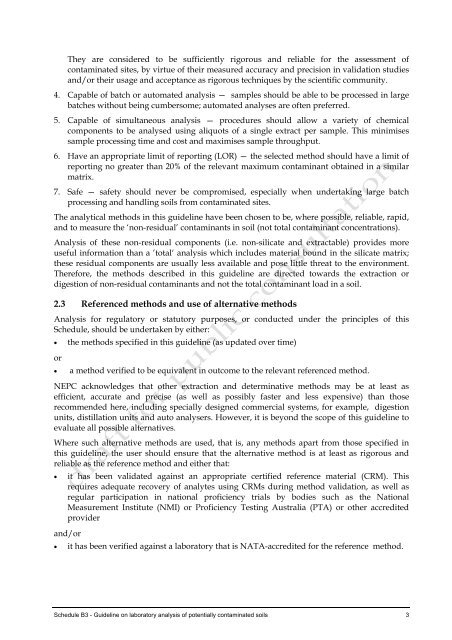Schedule B3 - COAG Standing Council on Environment and Water
Schedule B3 - COAG Standing Council on Environment and Water
Schedule B3 - COAG Standing Council on Environment and Water
- No tags were found...
Create successful ePaper yourself
Turn your PDF publications into a flip-book with our unique Google optimized e-Paper software.
They are c<strong>on</strong>sidered to be sufficiently rigorous <strong>and</strong> reliable for the assessment of<br />
c<strong>on</strong>taminated sites, by virtue of their measured accuracy <strong>and</strong> precisi<strong>on</strong> in validati<strong>on</strong> studies<br />
<strong>and</strong>/or their usage <strong>and</strong> acceptance as rigorous techniques by the scientific community.<br />
4. Capable of batch or automated analysis — samples should be able to be processed in large<br />
batches without being cumbersome; automated analyses are often preferred.<br />
5. Capable of simultaneous analysis — procedures should allow a variety of chemical<br />
comp<strong>on</strong>ents to be analysed using aliquots of a single extract per sample. This minimises<br />
sample processing time <strong>and</strong> cost <strong>and</strong> maximises sample throughput.<br />
6. Have an appropriate limit of reporting (LOR) — the selected method should have a limit of<br />
reporting no greater than 20% of the relevant maximum c<strong>on</strong>taminant obtained in a similar<br />
matrix.<br />
7. Safe — safety should never be compromised, especially when undertaking large batch<br />
processing <strong>and</strong> h<strong>and</strong>ling soils from c<strong>on</strong>taminated sites.<br />
The analytical methods in this guideline have been chosen to be, where possible, reliable, rapid,<br />
<strong>and</strong> to measure the ‘n<strong>on</strong>-residual’ c<strong>on</strong>taminants in soil (not total c<strong>on</strong>taminant c<strong>on</strong>centrati<strong>on</strong>s).<br />
Analysis of these n<strong>on</strong>-residual comp<strong>on</strong>ents (i.e. n<strong>on</strong>-silicate <strong>and</strong> extractable) provides more<br />
useful informati<strong>on</strong> than a ’total‘ analysis which includes material bound in the silicate matrix;<br />
these residual comp<strong>on</strong>ents are usually less available <strong>and</strong> pose little threat to the envir<strong>on</strong>ment.<br />
Therefore, the methods described in this guideline are directed towards the extracti<strong>on</strong> or<br />
digesti<strong>on</strong> of n<strong>on</strong>-residual c<strong>on</strong>taminants <strong>and</strong> not the total c<strong>on</strong>taminant load in a soil.<br />
2.3 Referenced methods <strong>and</strong> use of alternative methods<br />
Analysis for regulatory or statutory purposes, or c<strong>on</strong>ducted under the principles of this<br />
<str<strong>on</strong>g>Schedule</str<strong>on</strong>g>, should be undertaken by either:<br />
• the methods specified in this guideline (as updated over time)<br />
or<br />
• a method verified to be equivalent in outcome to the relevant referenced method.<br />
NEPC acknowledges that other extracti<strong>on</strong> <strong>and</strong> determinative methods may be at least as<br />
efficient, accurate <strong>and</strong> precise (as well as possibly faster <strong>and</strong> less expensive) than those<br />
recommended here, including specially designed commercial systems, for example, digesti<strong>on</strong><br />
units, distillati<strong>on</strong> units <strong>and</strong> auto analysers. However, it is bey<strong>on</strong>d the scope of this guideline to<br />
evaluate all possible alternatives.<br />
Where such alternative methods are used, that is, any methods apart from those specified in<br />
this guideline, the user should ensure that the alternative method is at least as rigorous <strong>and</strong><br />
reliable as the reference method <strong>and</strong> either that:<br />
• it has been validated against an appropriate certified reference material (CRM). This<br />
requires adequate recovery of analytes using CRMs during method validati<strong>on</strong>, as well as<br />
regular participati<strong>on</strong> in nati<strong>on</strong>al proficiency trials by bodies such as the Nati<strong>on</strong>al<br />
Measurement Institute (NMI) or Proficiency Testing Australia (PTA) or other accredited<br />
provider<br />
<strong>and</strong>/or<br />
• it has been verified against a laboratory that is NATA-accredited for the reference method.<br />
<str<strong>on</strong>g>Schedule</str<strong>on</strong>g> <str<strong>on</strong>g>B3</str<strong>on</strong>g> - Guideline <strong>on</strong> laboratory analysis of potentially c<strong>on</strong>taminated soils 3
















